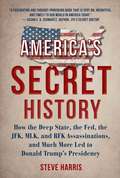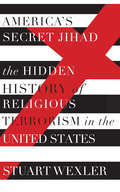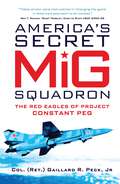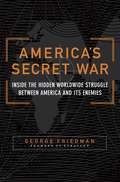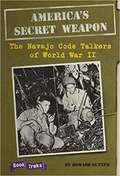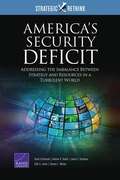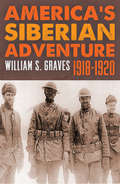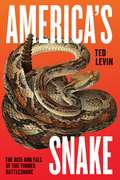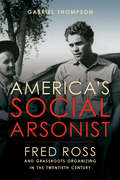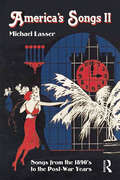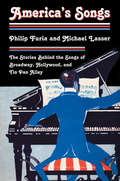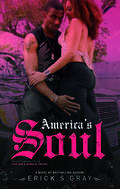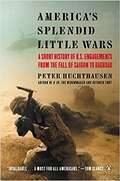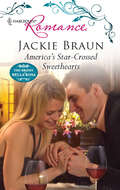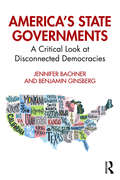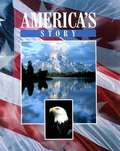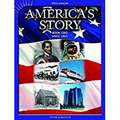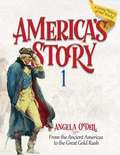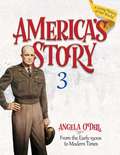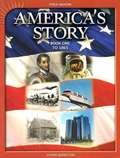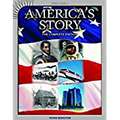- Table View
- List View
America's Secret History: How the Deep State, the Fed, the JFK, MLK, and RFK Assassinations, and Much More Led to Donald Trump's Presidency
by Steve HarrisThe Truth Behind the Stories They Don&’t Want You to KnowAmerica&’s Secret History presents an undistorted picture of the history of the United States. Never in one volume have so many unknown facts that disprove America&’s history books been brought together in a cohesive historical context, all based on verifiable information. Utilizing the House of Representative&’s little-known 1953 Reece Committee revelations, the Carnegie, Rockefeller, Guggenheim, and Ford foundations have systematically controlled education and the high-level appointees to the US State Department for the last century with the full knowledge and approval of the United States government.Conclusive proof that there has been one attempted coup d&’état, and three successful peaceful coups in America&’s history, and that all were obvious Deep State initiatives to mold the government into its intended purposes.Twenty-six people owned the same wealth as the poorest 50 percent of the world (almost four billion people in 2020). America&’s Secret History shows how the Deep State, the Fed, and world governments caused this to happen. Not another conspiracy theory book, America&’s Secret History reveals The Truth Behind the Stories They Don&’t Want You to Know, weaving all of them together to explain just how we find ourselves in Donald Trump&’s America.
America's Secret Jihad: The Hidden History of Religious Terrorism in the United States
by Stuart WexlerThe conventional narrative concerning religious terrorism inside the United States says that the first salvo occurred in 1993, with the first attack on the World Trade Center in New York City. This narrative has motivated more than a decade of wars, and re-prioritized America's domestic security and law enforcement agenda. But the conventional narrative is wrong.A different group of jihadists exists within US borders. This group has a long but hidden history, is outside the purview of public officials and has an agenda as apocalyptic as anything Al Qaeda has to offer. Radical sects of Christianity have inspired some of the most grotesque acts of violence in American history: the 1963 Birmingham Church bombing that killed four young girls; the "Mississippi Burning" murders of three civil rights workers in 1964; the assassination of Martin Luther King, Jr. in 1968, the Atlanta Child Murders in the late 1970s; and the Oklahoma City Bombing in 1995.America's Secret Jihad uses these crimes to tell a story that has not been told before.Expanding upon the author's ground-breaking work on the Martin Luther King, Jr. murder, and through the use of extensive documentation, never-before-released interviews, and a re-interpretation of major events, America's Secret Jihad paints
America's Secret MiG Squadron
by Gaillard R. PeckThis book is the story of a group of military pioneers who were intent on using their experience and knowledge to develop a new training paradigm for fighter pilots. As a Vietnam veteran and Phantom F-4 pilot, Col. Gail Peck (call-sign "EVIL") had been disappointed with the level of training offered to US fighter pilots. He was determined to ensure that US fighter pilots were unbeatable in the air particularly against their Cold War adversaries flying the already legendary MiG fighter jets. Working with the support of General Hoyt S. Vandenberg, Jr., and under conditions of the upmost secrecy the CONSTANT PEG program was launched with Peck as the original "Red Eagle."This fascinating unknown history was first revealed in Steve Davies' acclaimed Red Eagles: America's Secret MiGs but this book is the insider's perspective complete with never-before published anecdotes and photographs, revealing how Peck battled bureaucracy and skepticism to ultimately establish the premier fighter pilot training center. Along the way Peck explores many of the central questions surrounding the project: why did the combat Air Forces of the USA find themselves in need of a major revision in their approach to air-to-air combat training? How did they secretly build an airfield to clandestinely conduct air-to-air combat training using actual MiGs as the adversary training platforms? What was it like to be a Red Eagle pilot or maintainer and what were the major challenges they faced on a daily basis? What did the USA get out of the program in terms of a return on investment? Was it worth it and where do we go now?Despite operating for a decade no single pilot ever revealed the secret nature of the training until the program was eventually declassified in 2006. Now for the first time we can read about what it felt like to build the airfields, source the MiG aircraft and finally take them to the skies above America itself all in the quest to establish the USAF as the premier fighter jet force the world over.
America's Secret War: Inside the Hidden Worldwide Struggle Between America and Its Enemies
by George FriedmanDubbed by Barron's as "The Shadow CIA," Stratfor, George Friedman's global intelligence company, has provided analysis to Fortune 500 companies, news outlets, and even the U. S. government. Now Friedman delivers the geopolitical story that the mainstream media has been unable to uncover - the startling truth behind America's foreign policy and war effort in Afghanistan, Iraq, and beyond.
America's Secret Weapon: The Navajo Code Talkers of World War II
by Howard GutnerPhilip Johnston, who lived in California, was a veteran of World War I. He had an idea. Why not invent a code using the Navajo language? He gave a demonstration, and brought four Navajos to Camp Elliot and sent them into different offices. They talked by radio, translating messages from English to Navajo and back. A general named Clayton Vogel saw the demonstration and was convinced. In 20 seconds, the Navajos could code, send, and decode a message that took 30 minutes to send over a machine. General Vogel said that 200 Navajos should take part in the secret code project.
America's Security Deficit: Addressing the Imbalance Between Strategy and Resources in a Turbulent World
by Seth G. Jones Andrew R. Hoehn James T. Quinlivan David Ochmanek Edward L. WarnerThis report analyzes defense options available to the United States in responding to current and emerging threats to U. S. security and interests in Europe, the Middle East, and Asia. It focuses on ways that the United States might adapt military instruments to meet these emerging challenges, assessing in broad terms the cost of defense investments commensurate with the interests at stake.
America's Siberian Adventure 1918-1920 (Russia Observed Ser.)
by William GravesAmerica’s Siberian Adventure 1918-1920, first published in 1931, recounts the campaign by American troops to ostensibly help stabilize and bring peace to a region beleaguered by several long-standing conflicts. Author William Graves, the General in charge of the expeditionary force, had to contend with Russian warlords, the Red Army, a roving brigade of Czechoslovakian troops, the need to protect the Trans-Siberian Railway, extreme weather conditions, and the regular armies of the Japanese and British. These conflicting factions, plus the ill-defined nature of the mission were a recipe for potential disaster. However, credit must be given to the level-headedness displayed by General Graves as he worked desperately to keep a low-profile for American troops and avoid ‘adding fuel to the fire.’ After struggling for two years, American troops were withdrawn, with little to show for their efforts apart from the unfortunate loss of 189 soldiers. Included are 9 pages of illustrations. A related effort known as the North Russia Expeditionary Force experienced 235 deaths from all causes during their 9 months of fighting near Arkhangelsk.
America's Snake: The Rise and Fall of the Timber Rattlesnake
by Ted LevinThere's no sound quite like it, or as viscerally terrifying: the ominous rattle of the timber rattlesnake. It's a chilling shorthand for imminent danger, and a reminder of the countless ways that nature can suddenly snuff us out. Yet most of us have never seen a timber rattler. Though they're found in thirty-one states, and near many major cities, in contemporary America timber rattlesnakes are creatures mostly of imagination and innate fear. Ted Levin aims to change that with America's Snake, a portrait of the timber rattlesnake, its place in America's pantheon of creatures and in our own frontier history--and of the heroic efforts to protect it against habitat loss, climate change, and the human tendency to kill what we fear. Taking us from labs where the secrets of the snake's evolutionary history are being unlocked to far-flung habitats whose locations are fiercely protected by biologists and dedicated amateur herpetologists alike, Levin paints a picture of a fascinating creature: peaceable, social, long-lived, and, despite our phobias, not inclined to bite. The timber rattler emerges here as emblematic of America and also, unfortunately, of the complicated, painful struggles involved in protecting and preserving the natural world. A wonderful mix of natural history, travel writing, and exemplary journalism, America's Snake is loaded with remarkable characters--none more so than the snake at its heart: frightening, perhaps; endangered, certainly; and unquestionably unforgettable.
America's Social Arsonist: Fred Ross and Grassroots Organizing in the Twentieth Century
by Gabriel Thompson"A good organizer is a social arsonist who goes around setting people on fire."--Fred Ross Raised by conservative parents who hoped he would "stay with his own kind," Fred Ross instead became one of the most influential community organizers in American history. His activism began alongside Dust Bowl migrants, where he managed the same labor camp that inspired John Steinbeck's The Grapes of Wrath. During World War II, Ross worked for the release of interned Japanese Americans, and after the war, he dedicated his life to building the political power of Latinos across California. Labor organizing in this country was forever changed when Ross knocked on the door of a young Cesar Chavez and encouraged him to become an organizer. Until now there has been no biography of Fred Ross, a man who believed a good organizer was supposed to fade into the crowd as others stepped forward. In America's Social Arsonist, Gabriel Thompson provides a full picture of this complicated and driven man, recovering a forgotten chapter of American history and providing vital lessons for organizers today.
America's Social Health: Putting Social Issues Back on the Public Agenda
by Sandra Opdycke Marque-Luisa MiringoffCalling for a fundamental change in the focus of public policy in America, this book paints a vivid portrait of the nation's social health. Miringoff and Opdycke clearly show that social progress has stalled and the country's energies need to be directed at critical domestic issues in the years ahead.The authors propose a new agenda for monitoring America's social well-being built around sixteen key indicators of American life, such as infant mortality, teenage suicide, health insurance coverage, and affordable housing. They maintain that social conditions, like economic conditions, must be constantly monitored in order to have a clear sense of "how we are doing" as a society.The book builds on the work of the Institute for Innovation in Social Policy and argues that there needs to be a greater visibility for social issues - and a closer link between social reporting and public action - to better address the nation's social problems. It considers the critical role of the media in advancing public understanding of social issues, and examines important advances in the community indicators movement and international social reporting. Eye-opening and compelling, the book is a provocative centerpiece for policy debates and national initiatives on today's crucial domestic concerns.
America's Songs II: Songs from the 1890s to the Post-War Years
by Michael LasserAmerica’s Songs II: Songs from the 1890's to the Post-War Years continues to tell the stories behind popular songs in our country’s history, serving as a sequel to the bestselling America’s Songs: Stories Behind the Songs of Broadway, Hollywood, and Tin Pan Alley. Beginning in 1890 and ending in post-war America, America's Songs II is a testament to the richness of popular music in the first half of the 20th century. This volume builds on the unique features of the first volume, delving deeper into the nature of the collaboration between well-known songwriters of the time but also shedding light on some of the early performers to turn songs into hits. The book’s structure – a collection of short easy-to-read essays – allows the author to provide historical context to certain songs, but also to demonstrate how individual songs facilitated the popularity of specific genres, including ragtime, jazz, and blues, which subsequently reshaped the landscape of American popular music. America’s Songs II: Songs from the 1890's to the Post-War Years will appeal to American popular music enthusiasts but will also serve as an ideal reference guide for students or as a supplement in American music courses.
America's Songs: The Stories Behind the Songs of Broadway, Hollywood, and Tin Pan Alley
by Philip Furia Michael LasserFirst published in 2006. Routledge is an imprint of Taylor & Francis, an informa company.
America's Soul
by Erick S Gray Anthony WhyteSoul has just finished his 18-month sentence for a parole violation. Still in love with his son's mother, America, he wants nothing more than for them to become a family and move on from his past. But while Soul was in prison, America's music career started blowing up and she became entangled in a rocky relationship with a new man, Kendall. Kendall is determined to keep his woman by his side, and America finds herself caught in a tug of war between the two men. Soul turns his attention to battling the street life that landed him in jail - setting up a drug program to rid the community of its tortuous meth problem - but will Soul's efforts cross his former best friend, the murderous drug kingpin Omega?
America's Splendid Little Wars: A Short History Of U. S. Engagements From The Fall Of Saigon to Baghdad
by Peter HuchthausenFrom the evacuation of Saigon in 1975 to the end of the twentieth century, the United States committed its forces to more than a dozen military operations. Offering a fresh analysis of the Iranian hostage rescue attempt, the invasions of Granada and Panama, the first Gulf War, the missions in Somalia and Bosnia, and more, author and distinguished U.S. naval captain Peter Huchthausen presents a detailed history of each military engagement through eyewitness accounts, exhaustive research, and his unique insider perspective as an intelligence expert. This timely and riveting military history is “a must-read for anyone seeking to understand the nature of war today” (Stephen Trent Smith).
America's Star-Crossed Sweethearts
by Jackie BraunThe private life of baseball superstar Angelo "The Angel" Casali is a mystery, but sources say a reunion with his estranged father is his reason for returning to Italy. And now that he's been seen stepping off the plane with stunning-and scandalous-starlet Atlanta Jackson, he has added fuel to the media fire. After his latest injury, Angelo's career is in its final inning. Is this notorious playboy ready to settle down? Something tells us we haven't heard the last of our Angel...!
America's State Governments: A Critical Look at Disconnected Democracies
by Benjamin Ginsberg Jennifer BachnerThis timely and important new work takes a critical look at government in the American states and illustrates the disconnect between state government institutions and their constituents. The text illuminates three basic political problems of state governments: weak constitutional and institutional foundations; a lack of civic engagement; and long histories of unchecked public corruption. In addition, the book explains why some states did and others did not respond promptly to the COVID-19 pandemic and examines America's long-standing problem of police and prosecutorial misconduct–providing a context for understanding the demonstrations and protests that rocked American cities in the summer of 2020. For students and citizens of state politics, the book concludes with a proposal aimed at civic literacy and action
America's Story
by Richard G. Boehm Claudia Hoone Thomas M. Mcgowan Mabel C. McKinney-Browning Ofelia B. MiramontesThe stories told in each lesson contain the words and photographs of people in the past and primary sources, as well as descriptions by historians and secondary sources.
America's Story
by Jay Jacobs Howard B. Wilder Robert Phillips Ludlum Harriett Mccune BrownA textbook tracing the history of the United States from the arrival of the earliest settlers in prehistoric times to the present day.
America's Story
by Vivian BernsteinPresents the history of the United States beginning with the cultural heritage of Native Americans and concluding with American achievements in world leadership and technology.
America's Story (Book Two: Since 1865)
by Steck-Vaughn StaffA textbook tracing the history of the United States from the arrival of the earliest settlers in prehistoric times to the present day.
America's Story 1: From The Ancient Americas To The Great Gold Rush
by Angela O'DellThe vital resource that provides all assignments for the America’s Story Volume 1 course, which includes: Materials list for each chapter, oral narration questions and answers, directed journaling, artwork sketching and study sections, Map Adventures, optional Digging Deeper sections, and more.Book of Prayers, review sections, special project ideas, and answer keys. OVERVIEW: America’s Story Vol. 1 is written with narration as a key element of this course. Please take the time to employ oral narration whenever suggested. Included in each chapter of this Teacher Guide is a written narration prompt for the older child. Students will learn about the ancient Americas to the great Gold Rush, the infancy of our country through the founding of our great nation, catching glimpses of the leaders who would become known as the Founding Fathers. The course includes 28 chapters and five built-in reviews, making it easy to finish in one school year. The activity pages are an assortment of map adventures, areas to write/journal, Scriptures and famous sayings for copy work, hands-on projects, and pictures to draw and color. There is also a timeline project, including the simple instructions for completion. FEATURES: The calendar provides 5 daily lessons with clear objectives and activities.
America's Story 3: From the Early 1900s to Modem Times (America's Story Series #3)
by Angela O'DellAmerica’s Story 3 concludes the exciting journey through American History as students review America’s rich history, experience the excitement of discovery and invention as well as the hardships of the Great Depression, and examine the challenges our nation still faces. In America’s Story 3, students will: Discover the impact one president had on the New York City Police Department; Observe the first flight; Ride along with the development of the Model T; Experience the wonder and the tragedy of the Titanic; Explore America during & after the World Wars; Learn the hardships Americans faced during the Great Depression; Feel the excitement of new discoveries and technological advancement, and so much more! Through engaging narrative, O’Dell interacts with students and draws them in to imagine the adventures, hardships, failures, and triumphs of the incredible characters who shaped American history from the early 1900s to Modern Times.
America's Story 3: From the Early 1900s to Modern Times (America's Story Series #Vol. 3)
by Angela O'DellAmerica’s Story 3 concludes the exciting journey through American History as students review America’s rich history, experience the excitement of discovery and invention as well as the hardships of the Great Depression, and examine the challenges our nation still faces. In America’s Story 3, students will: Discover the impact one president had on the New York City Police Department; Observe the first flight; Ride along with the development of the Model T; Experience the wonder and the tragedy of the Titanic; Explore America during & after the World Wars; Learn the hardships Americans faced during the Great Depression; Feel the excitement of new discoveries and technological advancement, and so much more! Through engaging narrative, O’Dell interacts with students and draws them in to imagine the adventures, hardships, failures, and triumphs of the incredible characters who shaped American history from the early 1900s to Modern Times.
America's Story: Student Reader, Book One to 1865
by Vivian BernsteinAmerica's Story tells the story of the United States of America. This book tells how the United States began. It also tells how the United States changed from a small country to a large country.
America's Story: The Complete Edition
by Vivian BernsteinAmerica's Story tells the story of the United States of America. This book tells how this country changed from a small nation to a very large one. There are maps and pictures in each chapter. As you read America's Story, you will learn how Americans have worked to make this country a land of freedom for more than 225 years.
